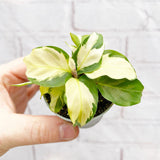Hoya Compacta Wax House Plant 6cm Pot
Hoya Compacta, also known as Hindu Rope plant, is a popular houseplant that is loved for its lush, thick, twisted, curly leaves. Here's a general care guide for this particular species:
Light: Hoya Compacta thrives in bright, indirect light. It can tolerate lower light conditions, but its growth may slow down and the plant may struggle to bloom. Avoid putting your plant in direct sunlight, as this could scorch the leaves. Ideal locations could include near a North or East facing window, or further back from a South or West facing window to avoid harsh direct sunlight.
Temperature: Hoya Compacta prefers average to warm temperatures. Ideal temperatures range from 60 to 85 degrees Fahrenheit (15 to 29 degrees Celsius). The plant will not tolerate frost, so make sure to bring it indoors or move it away from drafty windows during cooler months. It's a tropical plant, so higher humidity can be beneficial.
Water: Watering Hoya Compacta should be done thoroughly, allowing the water to drain completely out the bottom of the pot. Then wait until the top inch or so of the soil is dry before watering again. Overwatering can lead to root rot, so it's crucial to avoid waterlogged soil.
Humidity: Hoya Compacta, like many Hoyas, are native to tropical and subtropical regions, and therefore they do well in higher humidity. That being said, they can usually adapt to the lower humidity found in most homes. If you notice the leaves looking a bit wrinkled or puckered, it might benefit from increased humidity.
Soil: A well-draining soil mix is essential for Hoya Compacta. You can use a regular houseplant potting mix with added perlite or coarse sand to improve drainage. Hoyas also do well in orchid bark mixes.
Fertilizer: Feed your Hoya Compacta once every two weeks in the spring and summer with a balanced, water-soluble fertilizer. Make sure to dilute the fertilizer to half the recommended strength to avoid burning the roots. Reduce feeding in fall and winter, when the plant's growth naturally slows down.
Repotting: Hoyas are generally slow-growing plants and have no problem being a bit root-bound, so you won't need to repot your Hoya Compacta frequently. Every 2-3 years is typically sufficient, and spring or early summer is the best time to repot. Choose a pot that's only slightly larger than the previous one, as too much extra soil can hold excess water and potentially cause root rot.
Pruning: Hoya Compacta doesn't require a lot of pruning. However, you can prune your plant if it's getting too large or if you want to encourage a bushier appearance. Always use clean, sharp tools to make cuts. Do not remove the long tendrils, as this is where new leaves and flowers develop.
Blooming: Getting a Hoya to bloom can sometimes be a challenge, as they prefer being a bit root-bound and like bright light. They also produce flowers from the same spot (called a spur) year after year, so avoid removing these spurs. With patience and the right care, your Hoya Compacta should eventually reward you with clusters of beautiful, fragrant flowers.
Pest Control: Watch out for common pests like aphids, mealybugs, and spider mites. If you notice small discolored spots or tiny webs, use an insecticidal soap or a mixture of water and dish soap to treat the plant. Make sure to isolate the plant from your other houseplants to prevent the pests from spreading.
Remember that every plant is unique and may require slightly different care depending on its specific environment and conditions. Always observe your plant's health and adjust its care
Check out our YouTube video to see exactly how we pack for safe delivery.
- Plants are supplied in plastic nursery pots unless stated in the product title.
- Plants are not for consumption unless stated as edible.
- Plant heights can fluctuate +/- 10%.
- Our plants are kept at our tropical nursery in Yorkshire where we maintain an average temperature of 18c.


































